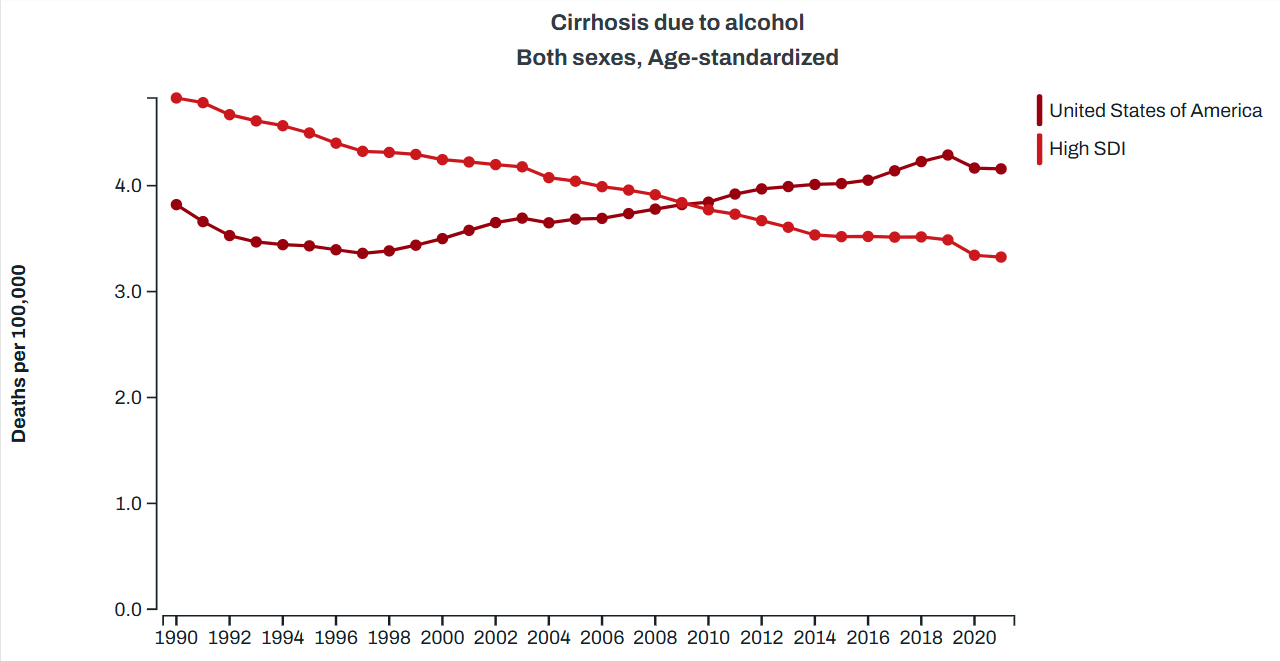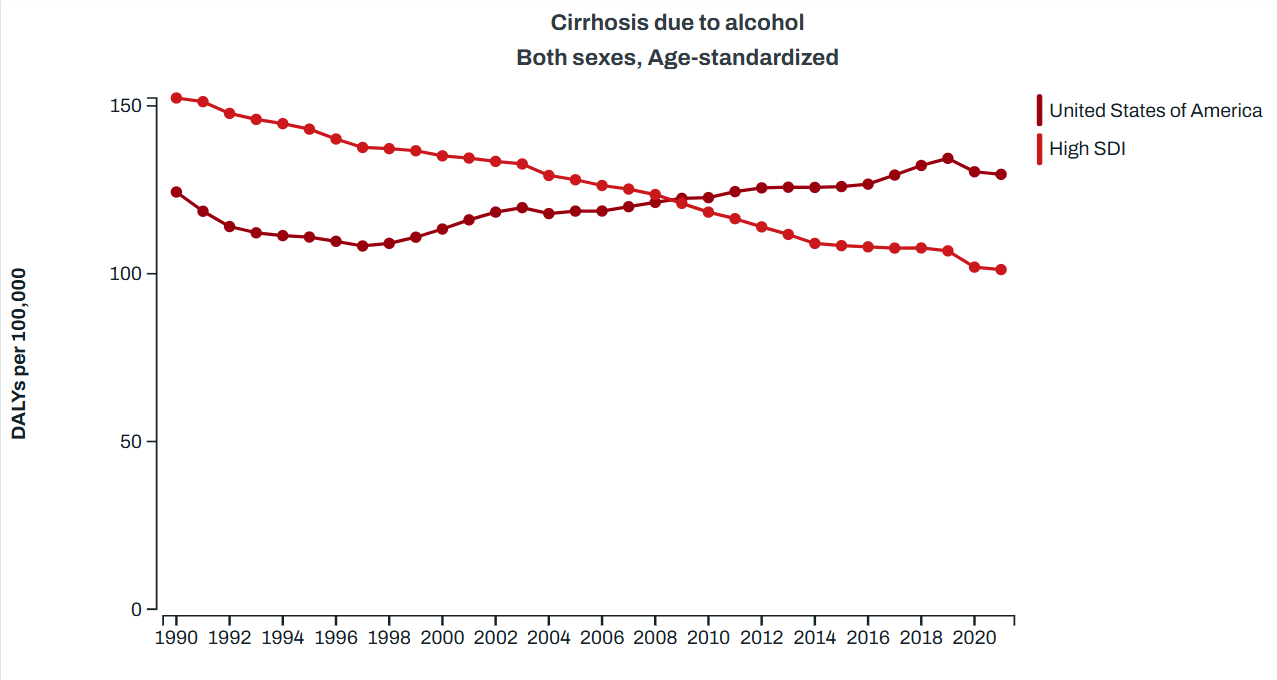Sunday Poster Session
Category: Liver
P1508 - Trends in Mortality and Disability Due to Alcoholic Cirrhosis in the United States Compared to High Socio-Demographic Index Countries From 1990-2021: Insights From the Global Burden of Disease Study
Sunday, October 26, 2025
3:30 PM - 7:00 PM PDT
Location: Exhibit Hall

Ayesha Ishtiaq, MBBS (she/her/hers)
Federal Medical and Dental College
Islamabad, Islamabad, Pakistan
Presenting Author(s)
Humza Saeed, 1, Adnan Bhat, MD2, Omar Al-Radideh, MD3, Ayesha Ishtiaq, MBBS4
1Rawalpindi Medical University, Rawalpindi, Punjab, Pakistan; 2University of Florida, Gainesville, FL; 3University of Florida College of Medicine, Gainesville, FL; 4Federal Medical and Dental College, Islamabad, Islamabad, Pakistan
Introduction: Alcoholic cirrhosis is a major cause of global liver-related morbidity and mortality, with rising prevalence in many high-income countries. Despite prevention efforts and medical advances, it remains a growing public health concern, especially in high-risk groups. This study compares trends in mortality and disability-adjusted life years (DALYs) between the United States (US) and other high Socio-demographic Index (SDI) countries.
Methods: Data on alcoholic cirrhosis–related mortality and DALYs were extracted from the Global Burden of Disease 2021 study, including age-standardized death rates (ASDR) and DALY rates per 100,000 from 1990 to 2021. Temporal trends were assessed for the US and compared with other high SDI countries. Joinpoint regression estimated annual and average annual percentage changes (APCs and AAPCs) with 95% confidence intervals (CIs); p < 0.05 was considered statistically significant.
Results: In the US, ASDR increased from 3.8 (95% CI: 3.4–4.2) in 1990 to 4.2 (95% CI: 3.6–4.7) in 2021, with an overall significant AAPC of 0.26 (95% CI: 0.20 to 0.33; p< 0.001). Significant periods of increase were observed from 1998 to 2002 (APC: 2.15; 95% CI: 1.76 to 2.67; p< 0.001) and from 2006 to 2019 (APC: 1.06; 95% CI: 0.99 to 1.24; p< 0.001). In contrast, high SDI countries experienced a consistent significant decline in ASDR from 4.8 (95% CI: 4.2–5.4) in 1990 to 3.3 (95% CI: 2.9–3.8) in 2021 (AAPC: -1.21; 95% CI: -1.25 to -1.18; p< 0.001) (Figure).
The US DALY rate increased from 124.3 (95% CI: 112.3–137.8) in 1990 to 129.6 (95% CI: 113.7–147.6) in 2021, with an overall significant AAPC of 0.12 (95% CI: 0.06 to 0.18; p< 0.001). Significant increases occurred from 2005 to 2016 (APC: 0.67; 95% CI: 0.46 to 0.82; p=0.005) and from 2016 to 2019 (APC: 1.65; 95% CI: 1.07 to 2.01; p< 0.001). In contrast, high SDI countries showed a consistent significant decline in DALY rate from 152.4 (95% CI: 131.4–171.8) in 1990 to 101.2 (95% CI: 88.3–114.7) in 2021 (AAPC: -1.34; 95% CI: -1.39 to -1.30; p< 0.001) (Figure).
Discussion: Despite overall declines in alcoholic cirrhosis–related mortality and DALYs in high SDI countries, the US has experienced a significant upward trend over the past three decades. This highlights growing disparities potentially driven by differences in public health policies, alcohol consumption, and access to preventive care. Targeted interventions and policy efforts are urgently needed to curb the rising burden in the US.

Figure: Trends in Age-Standardized Death Rates for Alcoholic Cirrhosis in the US and High SDI Countries (1990–2021)

Figure: Trends in Age-Standardized Disability-Adjusted Life Years (DALYs) for Alcoholic Cirrhosis in the US and High SDI Countries (1990–2021)
Disclosures:
Humza Saeed indicated no relevant financial relationships.
Adnan Bhat indicated no relevant financial relationships.
Omar Al-Radideh indicated no relevant financial relationships.
Ayesha Ishtiaq indicated no relevant financial relationships.
Humza Saeed, 1, Adnan Bhat, MD2, Omar Al-Radideh, MD3, Ayesha Ishtiaq, MBBS4. P1508 - Trends in Mortality and Disability Due to Alcoholic Cirrhosis in the United States Compared to High Socio-Demographic Index Countries From 1990-2021: Insights From the Global Burden of Disease Study, ACG 2025 Annual Scientific Meeting Abstracts. Phoenix, AZ: American College of Gastroenterology.
1Rawalpindi Medical University, Rawalpindi, Punjab, Pakistan; 2University of Florida, Gainesville, FL; 3University of Florida College of Medicine, Gainesville, FL; 4Federal Medical and Dental College, Islamabad, Islamabad, Pakistan
Introduction: Alcoholic cirrhosis is a major cause of global liver-related morbidity and mortality, with rising prevalence in many high-income countries. Despite prevention efforts and medical advances, it remains a growing public health concern, especially in high-risk groups. This study compares trends in mortality and disability-adjusted life years (DALYs) between the United States (US) and other high Socio-demographic Index (SDI) countries.
Methods: Data on alcoholic cirrhosis–related mortality and DALYs were extracted from the Global Burden of Disease 2021 study, including age-standardized death rates (ASDR) and DALY rates per 100,000 from 1990 to 2021. Temporal trends were assessed for the US and compared with other high SDI countries. Joinpoint regression estimated annual and average annual percentage changes (APCs and AAPCs) with 95% confidence intervals (CIs); p < 0.05 was considered statistically significant.
Results: In the US, ASDR increased from 3.8 (95% CI: 3.4–4.2) in 1990 to 4.2 (95% CI: 3.6–4.7) in 2021, with an overall significant AAPC of 0.26 (95% CI: 0.20 to 0.33; p< 0.001). Significant periods of increase were observed from 1998 to 2002 (APC: 2.15; 95% CI: 1.76 to 2.67; p< 0.001) and from 2006 to 2019 (APC: 1.06; 95% CI: 0.99 to 1.24; p< 0.001). In contrast, high SDI countries experienced a consistent significant decline in ASDR from 4.8 (95% CI: 4.2–5.4) in 1990 to 3.3 (95% CI: 2.9–3.8) in 2021 (AAPC: -1.21; 95% CI: -1.25 to -1.18; p< 0.001) (Figure).
The US DALY rate increased from 124.3 (95% CI: 112.3–137.8) in 1990 to 129.6 (95% CI: 113.7–147.6) in 2021, with an overall significant AAPC of 0.12 (95% CI: 0.06 to 0.18; p< 0.001). Significant increases occurred from 2005 to 2016 (APC: 0.67; 95% CI: 0.46 to 0.82; p=0.005) and from 2016 to 2019 (APC: 1.65; 95% CI: 1.07 to 2.01; p< 0.001). In contrast, high SDI countries showed a consistent significant decline in DALY rate from 152.4 (95% CI: 131.4–171.8) in 1990 to 101.2 (95% CI: 88.3–114.7) in 2021 (AAPC: -1.34; 95% CI: -1.39 to -1.30; p< 0.001) (Figure).
Discussion: Despite overall declines in alcoholic cirrhosis–related mortality and DALYs in high SDI countries, the US has experienced a significant upward trend over the past three decades. This highlights growing disparities potentially driven by differences in public health policies, alcohol consumption, and access to preventive care. Targeted interventions and policy efforts are urgently needed to curb the rising burden in the US.

Figure: Trends in Age-Standardized Death Rates for Alcoholic Cirrhosis in the US and High SDI Countries (1990–2021)

Figure: Trends in Age-Standardized Disability-Adjusted Life Years (DALYs) for Alcoholic Cirrhosis in the US and High SDI Countries (1990–2021)
Disclosures:
Humza Saeed indicated no relevant financial relationships.
Adnan Bhat indicated no relevant financial relationships.
Omar Al-Radideh indicated no relevant financial relationships.
Ayesha Ishtiaq indicated no relevant financial relationships.
Humza Saeed, 1, Adnan Bhat, MD2, Omar Al-Radideh, MD3, Ayesha Ishtiaq, MBBS4. P1508 - Trends in Mortality and Disability Due to Alcoholic Cirrhosis in the United States Compared to High Socio-Demographic Index Countries From 1990-2021: Insights From the Global Burden of Disease Study, ACG 2025 Annual Scientific Meeting Abstracts. Phoenix, AZ: American College of Gastroenterology.
